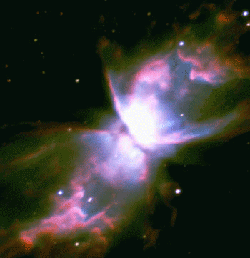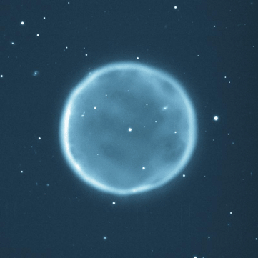The first detection of magnetic fields in the central stars... (4 January 2005)
- Details
- Published on 04 January 2005
Released on January 4th, 2005
The first detection of magnetic fields in the central stars of four planetary nebulae
''Discovery of magnetic fields in central stars of planetary nebulae'',
by S. Jordan, K. Werner and S. O'Toole
(Published in Astronomy & Astrophysics.)
The observed shapes of planetary nebulae are very puzzling: most of them (about 80%) are bipolar or elliptical rather than spherically symmetric. This complexity has lead to beautiful and amazing images obtained with modern telescopes. The pictures below compare planetary nebulae with bipolar (left) and spherical (right) shapes.

The bipolar Butterfly Nebula NGC 6302
Copyright: ESO |

The spherical Abell 39 Nebula
Copyright: WIYN/NOAO/NSF |
The reason why most planetary nebulae are not spherical is not well understood. Several hypotheses have been considered so far. One of them suggests that the strange shapes of planetary nebulae might be due to some centrifugal effect that results from the fast rotation of red giants. Another theory is that the symmetry of the star's wind may be affected by a companion star. However, the most recent and convincing theories explaining the shapes of the nebulae involve magnetic fields.
There are several ways magnetic fields can be created in the vicinity of planetary nebulae. Magnetic fields can be produced by a stellar dynamo during the phase when the nebula is ejected. For a dynamo to exist, the core of the star must rotate faster than the envelope (as is the case in the Sun). It is also possible that the magnetic fields are fossil relics of previous stages of stellar evolution. Under most circumstances, the matter in stars is so highly electrically conductive that magnetic fields can survive for millions or billions of years. Both mechanisms, combined with the interaction of the ejected matter with the surrounding interstellar gas, would be able to shape the planetary nebulae.
Until recently, the idea that magnetic fields are an important ingredient in the shaping od planetary nebulae was a purely theoretical claim. In 2002, the first indications of the presence of such magnetic fields were found. Radio observations revealed magnetic fields in circumstellar envelopes of giant stars. These circumstellar envelopes are indeed progenitors of planetary nebulae. However, no such magnetic field has ever been observed in the nebulae themselves. To obtain direct clue of the presence of magnetic fields in planetary nebulae, astronomers decided to focus on the central stars, where the magnetic fields should have survived.
This first direct evidence has now been obtained. For the first time, Stefan Jordan and his team [1] detected magnetic fields in several central stars of planetary nebulae. Using the FORS1 spectrograph of the 8-m class Very Large Telescope (VLT, European Southern Observatory, Chile), they measured the polarization of the light emitted by four of these stars. The polarization signatures in the spectral lines make it possible to determine the intensity of the magnetic fields in the observed stars. In the presence of a magnetic field, atoms change their energy in a characteristic way; this effect is called the Zeeman effect and was discovered in 1896 by Pieter Zeeman in Leiden (Netherlands). If these atoms absorb or emit light, the light becomes polarized. This makes it possible to determine the strength of the magnetic field by measuring the strength of the polarization. These polarization signatures are usually very weak. Such measurements require very high quality data that can only be obtained using 8-meter class telescopes such as the VLT.
Four central stars of planetary nebulae were observed by the team and magnetic fields were found in all of them. These four stars were chosen because their associated planetary nebulae (named NGC 1360, HBDS1, EGB 5, and Abell 36) are all non-spherical. Therefore, if the magnetic field hypothesis to explain the shapes of planetary nebulae is correct, these stars should have strong magnetic fields. These new results show that it is indeed the case: the strengths of the detected magnetic fields range from 1000 to 3000 Gauss, that is about one thousand times the intensity of the Sun’s global magnetic field.
These new observations published by Stefan Jordan and his colleagues support the hypothesis that magnetic fields play a major role in shaping planetary nebulae. The team now plans to search for magnetic fields in the central stars of spherical planetary nebulae. Such stars should have weaker magnetic fields than the ones just detected. These future observations will allow astronomers to better quantify the correlation between magnetic fields and the strange shapes of planetary nebulae.
In the few past years, polarimetric observations with the VLT have led to the discovery of magnetic fields in a large number of stellar objects in late evolutionary stages. In addition to improving our understanding of these beautiful planetary nebulae form, the detection of these magnetic fields allows science to take a step forward towards the clarification of the relationship between magnetic fields and stellar physics.
Discovery of magnetic fields in central stars of planetary nebulae
by S. Jordan, K. Werner and S. O'Toole
Published in Astronomy & Astrophysics (DOI number: 10.1051/0004-6361:20041993)
Contact persons:
- Science:
Dr. Stefan Jordan
Astronomisches Rechen-Institut
Moenchhofstr. 12-14
D-69120 Heidelberg, Germany
Phone: +49 6221 405 242 - Email: This email address is being protected from spambots. You need JavaScript enabled to view it.
- Press office:
Dr. Jennifer Martin
Journal Astronomy & Astrophysics
61, avenue de l'Observatoire
75014 Paris, France
Phone: +33 1 43 29 05 41 - Email: This email address is being protected from spambots. You need JavaScript enabled to view it.
© Astronomy & Astrophysics 2004


